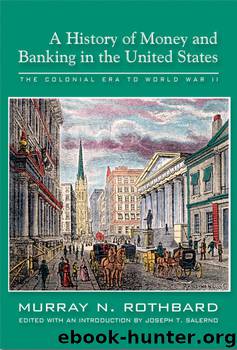A History of Money and Banking in the United States by Murray N. Rothbard

Author:Murray N. Rothbard [Rothbard, Murray N.]
Language: eng
Format: epub
Publisher: Ludwig von Mises Institute
BANKING AND FINANCIAL LEGISLATION: 1933–1935
The Rockefellers’ and other financiers’ war with the Morgans in 1933 had been building for several years. By the late 1920s, the Rockefellers, along with newly rising financial groups, increasingly resented the Morgan grip over both the Federal Reserve, especially the New York Fed, as well as the administration. Bankers enraged at Benjamin Strong and the New York Fed’s low-interest policy on behalf of Britain in the 1920s, were led by Melvin A. Traylor, head of the Rockefeller-controlled First National Bank of Chicago. The Rockefellers had never been England-oriented. Traylor led the Chicago bankers in going to the Democratic convention in 1928 and supporting Al Smith, the Democratic nominee. Averell Harriman, of Brown Brothers, Harriman, solidified his support of the Democratic Party during the same year and for similar reasons. Also, brash new ethnic groups rose to challenge Morgan hegemony and were fiercely fought by the Morgans and their controlled New York Fed: these included the Bank of America, a huge new Italian-American-run commercial bank chain in the West; and the rising Irish-American buccaneer Joseph P. Kennedy of Boston, both of whom were Democrats and emphatically outside the WASP-Morgan-Republican structure.
The crucial event occurred within the Morgans’ showcase New York institution, the Chase National Bank, a commercial bank with an investment banking arm, Chase Securities. As a result of the 1929 crash, the Rockefeller-controlled Equitable Trust Company was in vulnerable shape, and its new head, Winthrop W. Aldrich, engineered a merger into Chase in March 1930, making Chase the world’s largest bank. Aldrich was the brother-in-law of John D. Rockefeller, and was destined to be for decades the key Rockefeller man in banking as well as in the manipulation of politicians.
A titanic three-year struggle immediately ensued for control of Chase between the Rockefeller and the Morgan forces, who had previously been in charge. The CEO of Chase had been Morgan man Albert H. Wiggin, with Wiggin ally Charles McCain as chairman of the board. The Rockefeller forces quickly mobilized to make Winthrop Aldrich president of the bank, a move fought desperately but unsuccessfully by Morgan partner Thomas W. Lamont. Aldrich was now president and subordinate to Wiggin and McCain, but the nose of the camel was now in the tent, as Aldrich strove to oust Wiggin and McCain and take over the bank. Supporting Aldrich in this struggle were board members Thomas M. Debevoise, fraternity brother and top counsel to John D. Rockefeller, Jr.;55 Vincent Astor, of the famed Astor family and friend and cousin of Franklin Roosevelt; and Gordon Auchincloss, close friend of Winthrop Aldrich. As the conflict came to a climax in late 1932, Lamont found to his horror that several high Chase officials in the Aldrich camp were supporting Roosevelt. Cementing the closeness of Rockefeller and Chase National to Franklin D. Roosevelt was the crucial role of the shadowy, dominant adviser to President Woodrow Wilson, “Colonel” Edward Mandell House. House, a Democratic politician from Texas, had inherited railroads and other properties in Texas, and, during Wilson’s day, was very close to the Morgans.
Download
This site does not store any files on its server. We only index and link to content provided by other sites. Please contact the content providers to delete copyright contents if any and email us, we'll remove relevant links or contents immediately.
International Integration of the Brazilian Economy by Elias C. Grivoyannis(99336)
The Radium Girls by Kate Moore(11978)
Turbulence by E. J. Noyes(7983)
Nudge - Improving Decisions about Health, Wealth, and Happiness by Thaler Sunstein(7662)
The Black Swan by Nassim Nicholas Taleb(7063)
Rich Dad Poor Dad by Robert T. Kiyosaki(6517)
Pioneering Portfolio Management by David F. Swensen(6261)
Man-made Catastrophes and Risk Information Concealment by Dmitry Chernov & Didier Sornette(5958)
Zero to One by Peter Thiel(5736)
Secrecy World by Jake Bernstein(4703)
Millionaire: The Philanderer, Gambler, and Duelist Who Invented Modern Finance by Janet Gleeson(4425)
The Age of Surveillance Capitalism by Shoshana Zuboff(4252)
Skin in the Game by Nassim Nicholas Taleb(4206)
Bullshit Jobs by David Graeber(4143)
The Money Culture by Michael Lewis(4138)
Skin in the Game: Hidden Asymmetries in Daily Life by Nassim Nicholas Taleb(3962)
The Dhandho Investor by Mohnish Pabrai(3729)
The Wisdom of Finance by Mihir Desai(3698)
Blockchain Basics by Daniel Drescher(3544)
